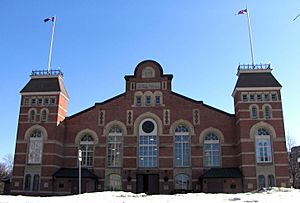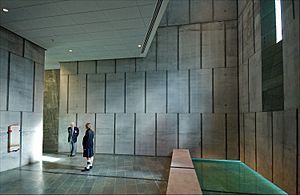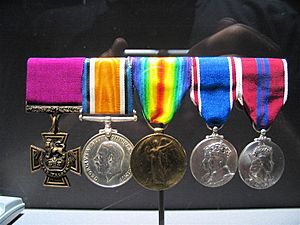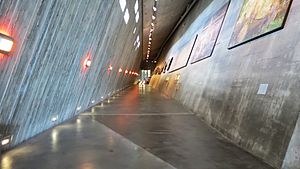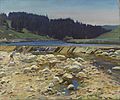Canadian War Museum facts for kids
| Musée canadien de la guerre | |

Exterior of the museum in 2022
|
|
| Established | January 1942 |
|---|---|
| Location | 1 Vimy Place, Ottawa, Ontario, Canada |
| Type | War museum |
| Architect | Moriyama & Teshima Architects & Griffiths Rankin Cook Architects |
| Owner | Canadian Museum of History |
| Public transit access | |
| Canadian Museum of History network | |
|
|
The Canadian War Museum (CWM) is a special place in Ottawa, Ontario, Canada. It's a national museum that tells the story of Canada's military past. Think of it as a giant history book you can walk through!
This museum is both a learning center and a place to remember important events. It's a big building, about 40,860 square meters (440,000 square feet). It sits near the Ottawa River in an area called LeBreton Flats. Inside, you'll find many exhibits, memorials, a cafeteria, and even a theatre. There are also special areas for keeping and studying historical items. The museum also has a library and archives called the Military History Research Centre.
The Canadian War Museum officially started in 1942. But some of its collections are even older, coming from a military museum that existed from 1880 to 1896. Over the years, the museum moved to different buildings and was managed by various groups. In 2005, a brand new building was opened at LeBreton Flats. It was designed by Moriyama & Teshima Architects and Griffiths Rankin Cook Architects.
The museum has a huge collection of over 500,000 items. These items are all about military history. This includes more than 13,000 pieces of military art. Besides its main exhibits, the museum also hosts special shows about Canada's military past.
Contents
History of the Museum
Early Beginnings
The museum's collection started with items from the Cartier Square Military Museum. This early museum began in 1880. Its goal was to save historical records and items from the Canadian Militia. This included things from Canada's earlier colonial times.
The museum quickly grew too big for its space. By 1886, people were asking for a new building. In 1896, the museum closed to make room for new rifles and training space. Its collections were moved to a warehouse.
Later, in the early 1900s, there wasn't much interest in reopening the museum. The items stayed in storage for a while.
Building the Collection
Eventually, a person named Arthur Doughty, who was in charge of the national archives, asked to move the military items. He wanted to display some of them. The military agreed, and many items were moved to the Dominion Archives between 1910 and 1919.
These items, along with German weapons captured in the First World War, were shown in a traveling exhibit in 1916. After the war, a group was formed to share war trophies across Canada. But they kept some important pieces for a future national museum. In 1924, a special building was built to hold this military collection.
The Museum Opens
The Canadian War Museum officially opened in January 1942. It was in the War Trophies Building. The Dominion Archives ran it, with some money from the Department of National Defence. In 1958, the National Museum of Canada took over its management.
In 1967, the museum moved to the original Dominion Archives building. This was next to the War Trophies building. The War Trophies building was then used for storage. Later, in 1990, the Canadian Museum of History Corporation took charge of the war museum.
By the 1990s, the museum's old building was too small and not good enough for the artifacts. A report in 1991 called the situation "embarrassing." People started raising money to help the museum.
A New Home in the 21st Century
In 2000, the government announced plans for a new museum building. At first, it was planned for a different location. But in 2001, Prime Minister Jean Chrétien decided it should be built at LeBreton Flats. This area used to be industrial and needed cleaning up. The museum would help make the area new again.
Construction for the new building started in November 2002. The site was cleaned up. By 2004, the museum began moving its large artifacts into the new space. The old buildings closed in early 2005.
The new Canadian War Museum opened on May 8, 2005. This date was special because it was the 60th anniversary of Victory in Europe day. The new building and its exhibits cost about C$135 million.
After it opened, there was some discussion about how the museum showed certain events. For example, some people had different ideas about how the Combined Bomber Offensive in World War II should be explained. The museum listened to feedback and made changes to some of its descriptions.
Museum Location and Design

The museum sits on a 7.5-hectare (18.5-acre) property in LeBreton Flats, Ottawa. This is Canada's capital city. It's southwest of Parliament Hill and the National War Memorial. The property is surrounded by roads, a pathway, and the Ottawa River. The museum even uses water from the river for cooling and watering the grounds.
Right next to the museum is a park called The Commons. The museum uses this park for different events. There's also a path on the building's green roof that connects The Commons to the parkland.
The Building's Unique Look
The museum building is about 40,860 square meters (440,000 square feet). It was designed by Moriyama & Teshima Architects and Griffiths Rankin Cook Architects. The main architects were Raymond Moriyama and Alex Rankin. The building cost around C$96 million to build.
The main idea behind the building's design is "regeneration." This means showing how war affects nature, and how nature can grow back and heal. The building has tilted and jagged shapes, with rough materials. This "controlled imperfection" is meant to make you think about the trauma of war.
Most of the building stays low to the ground. Only the eastern parts rise higher. A lot of concrete was used, along with reinforced steel. Many walls inside and out are at different angles, not just straight up and down.
Outside the Museum
The outside of the building looks like it's "emerging from a scarred landscape." This reflects the idea of war's devastation. The angular shape also makes it seem like it's rising from the Ottawa River. The tallest part of the building is 24 meters (79 feet) high. It faces towards the Canadian Parliament Buildings and the Peace Tower.
The museum has a large 20,500 square meter (220,660 square foot) green roof. This roof has plants that grow on their own. It connects to the nearby park and riverfront. The green roof helps the building fit with the regeneration theme. It also helps manage rainwater, saves energy, and cleans the air.

A large part of the southeastern side of the building is made of glass. This lets people outside see some of the items in the LeBreton Gallery. Near the top of the walls, small windows spell out "lest we forget/n'oublions jamais" in Morse code. The outside walls are made of concrete panels. The main entrance has aluminum frames and faces Parliament Hill.
Inside the Museum
Inside, many walls are made of concrete that includes recycled materials. This helps save energy. The walls rise sharply, and the floors have slight slopes. These designs are meant to make visitors feel a sense of instability, like the feeling of war. All the galleries have ramps and slopes, so they are easy for everyone to access.
The museum's lobby uses a lot of concrete and exposed steel. One wall looks like rough wooden planks, and another looks like large stone blocks. Copper from the old Library of Parliament roof is also used in the lobby. Most of the inside is simple and serious, to help visitors reflect. A 7-meter (23-foot) high video presentation shows what's inside the exhibits.
Other parts of the building include the Military History Resource Centre, which is a library and archive. There's also the 236-seat Barney Danson Theatre. This theatre is named after Barney Danson, who supported the museum. The building also has a special entrance for groups, a sunny cafeteria with a terrace, and labs for fixing artifacts. The total size of the museum building is 40,860 square meters (440,000 square feet).
Exhibitions and Galleries
The Canadian War Museum is both a history museum and a place for memory. Many of its permanent exhibits teach you about history and also help you remember. The main permanent exhibits are the Canadian Experience Galleries, Memorial Hall, Regeneration Hall, and the Royal Canadian Legion Hall of Honour. The Canadian Experience Galleries show Canadian military history in order, from oldest to most recent. Memorial Hall is free to visit and you can get to it from the lobby.
The museum's permanent exhibits were designed by Haley Sharpe Design and Origin Studios. They worked with museum historians to create exhibits that explore themes like brutality, geography, politics, and survival. The exhibits are divided into seven main areas, with 25 smaller topics. You'll find lots of text and pictures to help you learn.
The exhibit designers worked closely with the architects. This meant they could make the exhibits fit perfectly with the building's unique angular shapes. The exhibit areas use materials like steel, concrete, and wood, with strong, deep colors. This design is meant to make visitors feel the story of war. Sometimes, you'll see curved shapes that stand out from the many angular designs.
The museum also hosts special and traveling exhibits that change over time.
Canadian Experience Galleries

The Canadian Experience galleries cover 5,028 square meters (54,120 square feet). There are four galleries that tell the story of Canada's military history:
- Early Wars in Canada
- South African and the First World War
- Second World War
- From the Cold War to the Present
These galleries focus on events where Canadians were involved. They connect these events to bigger ideas about Canada as a nation. The exhibits are designed to show what it was like for Canadian soldiers and people at home. Each gallery has a main theme: geography, brutality, politics, or survival.

The Early Wars in Canada gallery looks at conflicts involving First Nations, and wars in New France and British North America. It also covers conflicts in the 1800s after Canada became a country. You'll see how geography shaped early battles. This gallery covers wars like the Beaver Wars, Anglo-French conflicts, the American Revolutionary War, the War of 1812, and the North-West Rebellion.
The South African and the First World War gallery shows Canada's part in the Second Boer War and the First World War. This gallery is designed to look like Canada in 1897, a time of strong national pride. In 2015, a new part of this gallery opened. It shows what life was like at home during the First World War. It covers topics like the Conscription Crisis of 1917 and the suffragette movement.
The Second World War gallery explains why the war started and Canada's role in it. It focuses on Canada's part in the Battle of the Atlantic, the British Commonwealth Air Training Plan, and the war in Europe. It also shows what happened on the homefront and the internment of Japanese Canadians. You'll see a Mercedes-Benz 770K car that belonged to Adolf Hitler. The museum got this car in 1970. There's also an M4 Sherman tank called Forceful III.
The last gallery, From the Cold War to the Present, explores Canada's role during the Cold War. It also looks at the fear of nuclear war. In 2017, this gallery was updated to include conflicts involving the Canadian Armed Forces after the Cold War. This part of the gallery encourages visitors to think about war, peace, and remembrance.
LeBreton Gallery: Military Technology
The LeBreton Gallery is a large open space filled with military equipment. You'll see items used by Canadians and other military forces. It's on the eastern side of the museum, and glass walls let in natural light.
The equipment is organized into different sections like land, air, and sea vehicles. You'll see field artillery, armored vehicles, cannons, and tanks. Most of these items have been restored and cleaned. Each piece has a label explaining its technical details. This gallery holds some of the museum's biggest items, like a McDonnell CF-101 Voodoo jet, 19th-century cannons, and many tanks and military vehicles from World War II and the Cold War.
Memorial Hall
Memorial Hall is in the museum's lobby. It's a quiet place for reflection and remembrance. The entrance is angled, making it feel narrow. The walls are covered in copper and lit softly. This part of the museum lines up with the Peace Tower on Parliament Hill.
Inside, the walls are smooth concrete with a grid pattern. This pattern looks like the headstones of Canadian soldiers from the First World War. Light comes in from a skylight above. There's also a glass pool of water. The design makes you feel a sense of lightness.
The hall holds one special item: the original headstone for the Canadian Tomb of the Unknown Soldier. A unique feature is that sunlight shines directly onto this headstone once a year. This happens on November 11 at exactly 11:00 AM. This is the exact time the First World War ended.
Regeneration Hall
Regeneration Hall is at the highest point of the museum. It represents "hope for a better tomorrow." The walls are angled like the buildings on Parliament Hill. You can see the Peace Tower through the glass on the eastern side. This hall displays artworks, including models for the Canadian National Vimy Memorial and a painting called Sacrifice by Charles Sims.
Royal Canadian Legion Hall of Honour
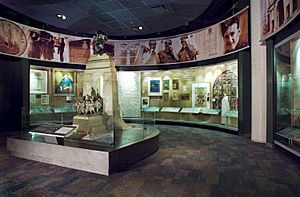
The Royal Canadian Legion Hall of Honour is an oval-shaped exhibit. It shows how Canada has remembered and honored its military history over time. In the center, you'll see the original plaster model for the National War Memorial.
Tall display cases line the walls. They hold certificates, letters, medals, models, paintings, photos, and souvenirs. These items are arranged in order of time, from First Nations history to modern Canada. Most displays focus on the 20th century. They tell individual stories and show different ways people have remembered those who served.
Museum Collection
As of 2015, the museum has over 500,000 items! This huge collection includes letters, documents, equipment, maps, medals, military art, vehicles, and uniforms. The museum gets about 700 offers for donations each year. It accepts about 100 to 150 of these. However, Canadian service medals are always accepted as a way to show honor. About 2,000 artworks and photos from the collection are used in the exhibits.
Items from the collection are either on display, traveling to other museums, loaned out, or kept in storage. Before 2004, items not on display were stored in different buildings. Now, all items are kept in a new storage space within the museum building.
The museum's collection started with items from the Cartier Square Military Museum in 1880. This included weapons, a bell from a ship called HMS Neptune, and flags from the War of 1812. The collection grew a lot during the First World War. After World War II, the museum sent teams to Europe to get German military equipment. During the Cold War, the Canadian Armed Forces gave the museum its old equipment.
In 1994, the museum had about 6,550 posters. Many were from Canada, but others came from the United Kingdom, the United States, and other countries. In 2019, the museum held 39 of the 99 original Victoria Crosses awarded to Canadians.
War Art Collection
As of 2015, the museum's Beaverbrook Collection of War Art has over 13,000 pieces. Most of these are drawings or paintings on paper. The museum has been involved in Canadian war art programs since 1971. That's when the National Gallery of Canada gave the war museum over 5,000 artworks from the Second World War. The art collection is named after Max Aitken, 1st Baron Beaverbrook, who started an early war art collection.
The museum's war art collection includes over 400 works by Alex Colville. Other artists in the collection include Alfred Bastien, Charles Comfort, and Frederick Varley. The collection also has models and statues. This includes the plaster model by Vernon March that was chosen for the National War Memorial. It also has the original models by Walter Seymour Allward for the Canadian National Vimy Memorial. These models are now shown in the Regeneration Hall exhibit.
The Canadian War Museum has organized major traveling art shows. One was called Canvas of War: Masterpieces from the Canadian War Museum. It traveled across Canada from 1999 to 2004.
Selected Artworks
-
Women Making Shells, by Mabel May, 1918
-
A Stream Bed at Labergement Jura Forest, by Alfred Munnings, 1918
-
Untitled, Pegi Nicol MacLeod, 1944
Library and Archives
The Military History Research Centre is a special part of the museum. It holds the Hartland Molson Library Collection and the George Metcalf Archival Collection. The library has books and rare materials about Canadian military history. The archives keep blueprints, old photos, films, journals, maps, and recordings. The research center has a reading area overlooking the river. It also has a special room for very old or delicate materials.
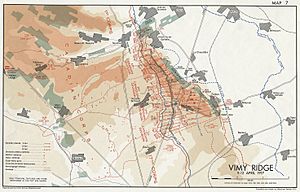
The museum didn't do much archiving until 1967. Before that, the Public Archives of Canada handled most war-related documents. After 1967, many documents were transferred to the war museum. In 1982, the museum's archives were organized into different groups.
The Military History Research Centre has an oral history archive. This means it has recordings of nearly 400 interviews from 2007. The museum started this program in 1999. They interview people who served in World War II, the United Nations Emergency Force, and other conflicts.
In 2000, the museum's photo archives had over 600 collections. This included more than 17,000 individual photos and over 250 photo albums. Most of these photos came from private sources, often people who took the pictures while serving in conflicts.
See also
- Lest We Forget Project
- List of military museums
- List of museums in Ottawa
- National museums of Canada
- National War Memorial (Canada)
- Organization of Military Museums of Canada
- Victor Suthren, former director general of the museum


